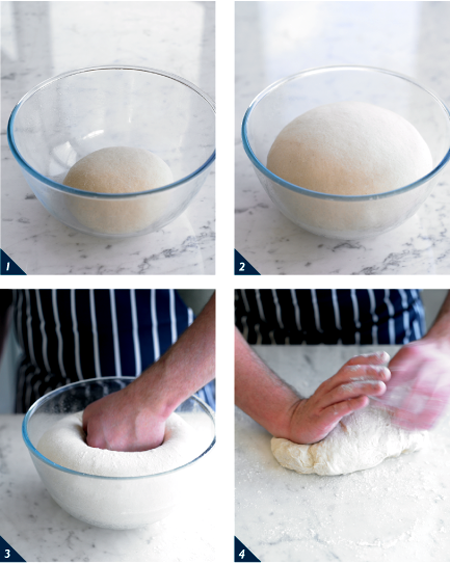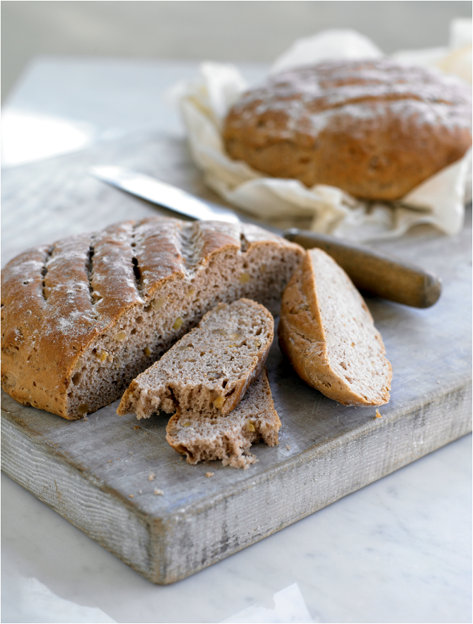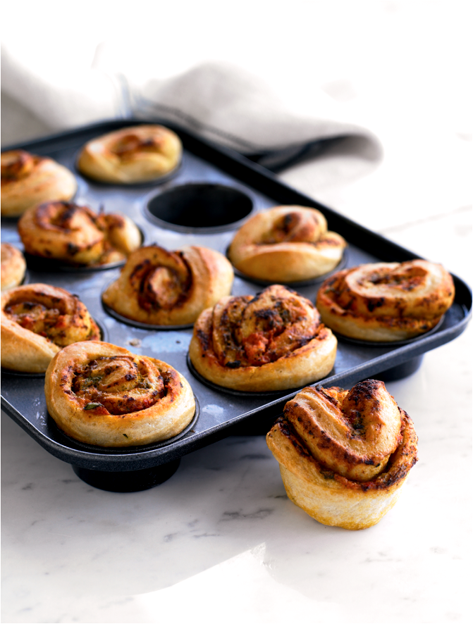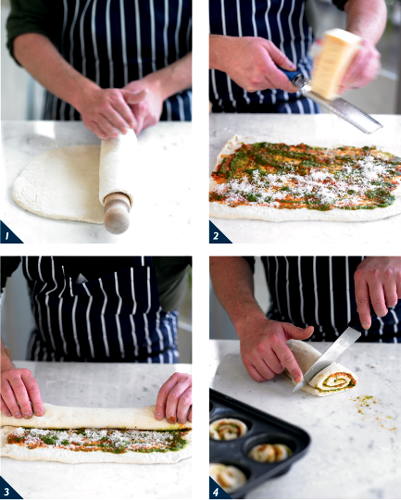
Полная версия
Home Chef
Dice To cut into very small cubes of similar size and shape.
Dredge To coat food with flour or another powdered ingredient.
Flambé To flavour a dish with alcohol, usually brandy or rum, which is then ignited so that the actual alcohol content is burnt off, leaving the flavour behind. This can be done with a lighter, although chefs tend to simply tilt the pan and use the flame of the gas! Take great care!!
Fold To gently blend two mixtures, releasing as little air as possible. Cut through the mixture with a spatula or whisk, from bottom to top, rotating the bowl constantly, until thoroughly mixed.
Fondant A classic, restaurant method of cooking potato, producing a deliciously rich and buttery potato dish. Also a baked dessert which is cake-like on the outside but soft in the centre.
Gelatine An unflavoured substance that gives body to mousses and desserts, and aids setting. Available in leaves or powdered form. Traditional forms are not suitable for vegetarians, though some versions now are. A good alternative is agar agar, which is now more widely available from good health food shops. Simply follow the instructions on the packet.
Hull To remove the tough part of fruit under the stalk (e.g. strawberries).
Marinade / To Marinate A marinade is an acidic-based liquid mixture combining various seasonings, used to flavour and tenderise (particularly meat). To marinate meat, either brush food with the mixture or immerse in it and leave for at least 1-3 hours but preferably overnight.
Poach To cook very gently in liquid kept just below boiling point.
Purée To mash until perfectly smooth, either by hand, by pushing through a sieve or by mixing in a food processor or liquidiser.
Reduce To simmer liquid without a lid until much of the moisture evaporates and the sauce has thickened.
Refresh To dip into cold water or run cold water over food that has been parboiled or ‘blanched’ in hot water. This stops food from cooking any further and keeps a good colour.
Rind Thin outer coloured layer of a citrus fruit’s skin. Can be removed with a special zester, a vegetable peeler or a box grater. Also the outer skin on bacon or cheese, which is normally removed.
Sauté To cook gently in a small amount of oil and butter in a pan over a low heat. The butter gives the flavour and the oil prevents it from burning. Also used to give the food a nice golden brown colour.
Seal To brown food very quickly on all sides to seal in juices and flavour, and to improve appearance and colour.
Seasoning A mixture of three parts salt to one part ground black pepper.
Simmer To keep a liquid or sauce at a point just below boiling, so that small bubbles rise slowly to the surface, breaking before they reach it.
Sweat To cook slowly in oil, butter or a mixture of both.
Syrup Sugar dissolved in liquid (usually water) over a medium heat.
Wilt To cook until limp, especially soft leaf vegetables such as spinach, rocket and pak choi.

Bread
MacNean White Bread
We serve this bread in the restaurant at the start of every meal. The basic recipe can be adapted in many ways – try adding to the dough up to 10 tablespoons of chopped fresh mixed soft herbs, such as flat-leaf parsley, basil and chives. Or add 4 tablespoons of Sun-dried Tomato Pesto (see page 208) along with a teaspoon of fennel seeds. Alternatively, spread the dough with Red Onion Marmalade (see page 209) before cooking.

700g (1 ‘Alb) strong unbleached white flour, plus extra for dusting
2 x 7g sachets of easy blend dried yeast
25g (1oz) caster sugar 1 tsp salt
olive oil, for oiling
1 egg beaten with 1 tbsp water
butter, to serve
You can make the dough in a food mixer or by hand. To make in a food mixer, place the flour in the bowl of the machine, and use the the dough hook attachment. Add the yeast, 450ml (16fl oz) lukewarm water, sugar and salt. Switch on the machine and mix until you have a very sloppy dough. Then knead on medium speed for 6-8 minutes until the dough becomes slightly sticky but pliable.
Alternatively, to make the bread by hand, place the flour in a large mixing bowl. Add the yeast, lukewarm water and salt and mix with your fingers for 2-3 minutes to incorporate the flour, scraping the sides of the bowl and folding the dough over itself until it gathers into a rough mass. Turn the dough out on to a well-floured work surface; lightly flour your hands. Knead for 6-8 minutes using the heel of your hand, until the dough is smooth and pliable. The dough will be very sticky at first; keep your hands and the work surface lightly floured, using a dough scraper if necessary to prevent it from sticking and building up on the work surface. As you continue kneading, the dough will become more elastic and easier to handle.
Shape the dough into a loose ball, then place in an oiled bowl and cover with cling film. Leave to rise for 1 hour until doubled in size.
Lightly oil two 450g (1lb) loaf tins. Knock back the risen dough by punching it lightly with a clenched fist to knock out trapped bubbles, then turn it out again on to a lightly floured surface and knead for 2-3 minutes until it becomes springy and very smooth. Divide the dough into two even-sized pieces and shape each into a rectangle using the length of the tin as a rough guide. Place in the prepared tins, smoothing down the tops and leave to prove (increase in size) for another 10 minutes until slightly risen.
Meanwhile, preheat the oven to 180°C (350°F), gas mark 4. Brush the tops of the loaves with the beaten egg mixture. Bake for 45 minutes until the loaves are a deep golden brown and sound hollow when tipped out of the tins and tapped on the bottom. Return to the tins and leave for 5 minutes on a heatproof surface, then transfer the bread to a wire rack and allow to cool completely before slicing.
To serve, cut the bread into slices and arrange in a bread basket with a pot of butter. Wrap any remaining bread in cling film and store in a bread bin or dark cupboard for 1-2 days.

1. Dough before being covered
2. After 1 hour: doubled in size
3. Knocking back the dough
4. Kneading with heel of hand
Multi Seed Wheaten Bread
This is the first thing we make every morning at the restaurant. Guests who have stayed overnight can wake up to the smell wafting around the house. The bread is delicious sprinkled with a couple of tablespoons of sesame seeds or sunflower seeds before baking. If you don’t have any buttermilk to hand, add the juice of a lemon to the same quantity of fresh milk and leave overnight before using.

rapeseed or sunflower oil, for oiling
450g (lib) plain flour, plus extra for dusting
450g (1 lb) coarse wholemeal flour
2 tsp bicarbonate of soda
2 tsp salt
100g (4oz) wheat bran
100g (4oz) mixed seeds, such as linseed, sunflower, sesame and poppy seeds
50g (2oz) butter
2 tbsp golden syrup
2 tbsp demerara sugar
1 litre (1% pints) buttermilk, plus a little extra if necessary
butter, to serve
Preheat the oven to 180°C (350°F), gas mark 4 and lightly oil two 900g (2lb) loaf tins.
Sift the flours, bicarbonate of soda and salt into a large bowl. Tip the bran left in the sieve into the bowl and stir in with the wheat bran and all but 1 tablespoon of the seeds (reserve them for the top). Rub the butter in with your fingertips until evenly dispersed.
Make a well in the centre of the dry ingredients and add the golden syrup, demerara sugar and the buttermilk. Using a large spoon, mix gently and quickly until you have achieved a fairly wet dropping consistency, making sure there are no pockets of flour remaining.
Divide the mixture evenly between the prepared loaf tins, spreading it evenly and smoothing the tops with the back of a spoon. Sprinkle over the reserved tablespoon of the seeds. Bake for hours until well risen and cracked on the top and so that a skewer comes out clean when inserted in the centre.
To check the loaves are properly cooked, tip each one out of the tin and tap the base. It should sound hollow. Return to the tin and allow to cool for about 5 minutes on a heatproof surface before tipping out on to a wire rack and leaving to cool completely.
This bread is best eaten on the day it is made. To serve, place on a bread board and cut into slices at the table. Hand around with a separate pot of butter.
Mediterranean Gluten-free Bread

olive oil, for oiling
600g (lib 6oz) gluten-free flour
½ tsp salt
2 tsp bicarbonate of soda
300g (11oz) soya bran
150g (5oz) light muscovado sugar
3 eggs
100ml (3½fl oz) Sun-dried Tomato Pesto (see page 208)
1 litre (1¾ pints) buttermilk
1 tbsp sesame seeds
butter, to serve
I’ve always had a tremendous response when I’ve served gluten-free recipes and this excellent recipe came from a pastry chef at Killybegs College, Noleen Boyle, who is coeliac herself. Don’t be surprised that it has a slightly different texture to ordinary bread. It stays fresh for about 2 days, so if you want to keep it for any longer cut into slices and freeze, then place in the oven to thaw out (for 8-10 minutes at 180°C/350°F/gas mark 4) or use a toaster. Gluten-free flour is now available from all major supermarkets and health food shops or can be bought online.
Preheat the oven to 180°C (350°F), gas mark 4. Lightly oil a 900g (2lb) loaf tin.
Sift the flour into a large mixing bowl with the salt and bicarbonate of soda, then stir in the soya bran and sugar.
Place the eggs, Sun-dried Tomato Pesto and buttermilk in a jug and mix well to combine.
Make a well in centre of the dry ingredients and pour in the buttermilk mixture, mixing to combine. Spoon the mixture into the oiled loaf tin and smooth the surface, using the back of a spoon. Sprinkle the sesame seeds on top.
Bake the bread for 1 hour until golden brown and crusty on top. Tip briefly from the tin and tap the base of the loaf to check it is cooked – it should sound hollow. Return to the tin and leave for 5 minutes on a heatproof surface, then turn the bread out on to a wire rack and allow to cool completely.
Once the bread has cooled down completely, place on a bread board and cut into slices at the table. Serve with butter.
Walnut & Fig Bread
This is a delicious breakfast bread and also makes a lovely sandwich filled with creamy blue cheese and rocket. Also try with Chicken Liver Pâté with Fig Jam (see page 83) or Red Onion Marmalade (see page 209). I find that it toasts very well after a day or two.

550g (lib 3‘/20z) strong plain white flour, plus extra for dusting
1 tsp salt
50g (2oz) butter, diced and chilled
7g sachet of easy blend dried yeast
100g (4oz) walnuts, roughly chopped
50g (2oz) dried ready-to-eat figs, finely chopped
sunflower oil, for oiling
butter, to serve
Sift the flour and salt into a large bowl. Rub in the butter until the mixture resembles fine breadcrumbs. Stir in the yeast, walnuts and figs until evenly combined.
Make a well in the centre of the dry ingredients and then pour in 350ml (12fl oz) lukewarm water. Quickly mix to a smooth dough, then turn out on to a lightly floured work surface and knead for 10 minutes until smooth and elastic. Place in an oiled bowl, cover with oiled cling film and leave to rise in a warm place for about 1 hour or until doubled in size.
Knock the dough back by punching it lightly with a clenched fist, then divide it in half, shaping each piece into a smooth round. Put on baking sheets lined with non-stick baking paper and cover each one with a damp tea towel. Leave to rise again in a warm place for about 30 minutes.
Preheat the oven to 220°C (425°F), gas mark 7. Remove the damp tea towel from the loaves and slash the tops 4-5 times with a sharp knife. Bake for 10 minutes, then reduce the oven temperature to 190°C (375°F), gas mark 5 and bake for another 25-30 minutes, swapping the sheets on the oven shelves halfway through cooking.
When cooked, the loaves should sound hollow if tapped on the bottom. Transfer to a wire rack and allow to cool completely. The bread can be wrapped in cling film and stored in a bread bin for 1-2 days.
To serve, arrange a loaf on a bread board and cut into slices at the table. Serve with butter.

Cheddar & Spring Onion White Soda Bread
This is a delicious variation on a classic Irish recipe. Experiment with other flavourings such as finely chopped sun-dried tomatoes or crispy pieces of smoked bacon. If you don’t have buttermilk, use fresh milk mixed with the juice of a lemon, and leave overnight before using.

450g (lib) plain flour, plus extra for dusting
1 tsp bicarbonate of soda
l tsp salt
100g (4oz) strong Cheddar, grated
4 spring onions, trimmed and finely chopped
350ml (12fl oz) buttermilk, plus a little extra if necessary
Preheat the oven to 230°C (450°F), gas mark 8. Sift the flour, bicarbonate of soda and salt into a large mixing bowl. Make a well in the centre of the dry ingredients and stir in the Cheddar and spring onions, then add the buttermilk. Using a large spoon, mix gently and quickly until you have achieved a nice soft dough. Add a little bit more buttermilk if necessary until the dough binds together without being sloppy.
Knead the dough very lightly on a lightly floured work surface and shape into a round of roughly 15cm (6in). Place on a non-stick baking sheet and cut a deep cross in the top. Bake for 15 minutes.
Reduce the oven temperature to 200°C (400°F), gas mark 6 and bake the loaf for another 20-25 minutes or until it is evenly golden and crusty. It should sound hollow when tapped on the bottom. If it doesn’t, return to the oven for another 5 minutes.
Transfer the cooked soda bread to a wire rack and allow to cool for about 20 minutes. This bread is best eaten while it is still warm, as it doesn’t store well. To serve, place the soda bread on a bread board and cut into slices at the table.
Variation Brown Soda Bread
Make as above but use 350g (12oz) plain flour mixed with 100g (4oz) coarse, stoneground wholemeal flour. Add 2 tablespoons of pinhead oatmeal to the mix before adding the buttermilk.
Red Onion, Olive & Rosemary Focaccia
This savoury Italian bread is made much like pizza. Semi sun-dried tomatoes or strips of roasted peppers also work well on top. This dough can be made even more easily in a food mixer.

7 tbsp extra-virgin olive oil, plus extra for oiling and drizzling
1 tsp easy blend dried yeast
450g (1lb) strong plain white flour, plus extra for dusting
1¼ tsp sea salt
1 large red onion, halved and cut into slices (keep them attached at the root)
100g (4oz) pitted black olives
1 sprig of rosemary, leaves stripped
salt and black pepper
Oil a 28 x 18 x 4cm (11 x 7 x 1½in) baking tin and line with nonstick baking paper. Mix the yeast, flour and ½ teaspoon of salt in a large mixing bowl. Make a well in the centre and pour in 225ml (8fl oz) lukewarm water and 5 tablespoons of olive oil. Mix well to form a soft dough, then turn out on to a lightly floured work surface and knead for 10 minutes until smooth and elastic. Place in an oiled mixing bowl, cover with oiled cling film and leave to rise in a warm place for about 1 hour or until doubled in size.
Turn the dough out on to a lightly floured surface and knock it back, punching lightly to knock out air bubbles, then knead for another 2-3 minutes. Roll out to a large rectangle about 1cm (½in) in thickness. Place in the prepared tin. Cover with oiled cling film and leave to rise again for 30 minutes – it should look soft and pillowy.
Meanwhile, preheat the oven to 220°C (425°F), gas mark 7. Heat 1 tablespoon of the olive oil in a small roasting tin and toss in the red onion. Season with salt and pepper and spread in an even layer, then roast for 15-20 minutes until just tender but not coloured.
Prick the risen dough all over with a fork. Stud with the olives, fan out the red onions on top, then scatter with the rosemary and the rest of the salt, and drizzle with the remaining olive oil. Bake for about 30 minutes until risen, cooked through and golden brown. Don’t worry that the onions will have tinged at the edges.
Leave in the tin for a few minutes, then turn out on to a wire rack to cool and drizzle with a little extra olive oil to keep the crust soft. Cut into chunks to serve. This is best served warm but also reheats well in a low oven or is fine when cold. To store, allow to cool, wrap in cling film and store in a bread bin for 1-2 days.
Tomato & Parmesan Twister Bread Rolls

For the dough
1 tbsp olive oil, plus extra for oiling
350g (12oz) strong plain bread flour, plus extra for dusting
1 tsp salt
7g sachet of easy blend dried yeast 1 egg beaten with 1 tbsp milk
For the filling
200g (7oz) Tomato Sauce (see page 214)
125g (4½oz) Pesto (see page 208)
75g (3oz) freshly grated Parmesan cheese
These bread rolls are easy to make and taste so much better than any you can buy in the shops. You can vary the fillings – try sun-dried tomato paste, tapenade, red onion marmalade, finely chopped sun-dried tomatoes or different cheeses – but go light on them or the fillings may burn while they are cooking. Turn the page for step-by-step pictures.
Preheat the oven to 200°C (400°F), gas mark 6. Lightly oil two 12-hole muffin tins.
Sift the flour into a large mixing bowl with the salt and stir in the dried yeast. Make a well in the centre and pour in the olive oil and 300ml (11fl oz) lukewarm water. Mix to a smooth dough.
Turn the dough out on to a lightly floured work surface and knead for 5-10 minutes, pushing and stretching the dough until smooth and elastic. Alternatively, use a food mixer with the dough hook attached and set on a low speed.
Place the dough in a large, lightly oiled bowl. Cover with a clean tea towel and leave in a warm place for 1 hour until the dough has almost doubled in size.
Knock the risen dough back, punching it lightly to knock out large air bubbles and knead it briefly on a lightly floured work surface. With a rolling pin, roll out the dough into a large rectangle, approximately 55 x 35cm (22 x 14in). Using a palette knife, spread over the tomato sauce and then spread the pesto on top. Sprinkle over the Parmesan cheese. Then, starting from one of the long edges, gently roll the dough away from you into a long Swiss roll shape. Don’t worry if it sticks a little, just gently coax it up a bit at a time with floured fingers until it reaches the other side and then press the seam together to stick. »

Cut the roll into 4cm (1½in) thick slices and place in the tin, one in each muffin hole, with one of the cut sides facing down. Brush the tops lightly with the beaten egg mixture and leave them to rise in a warm place for another 10 minutes or until doubled in size.
Bake the rolls for 20-25 minutes, swapping the tins on the shelves halfway through, until cooked through and golden brown. Leave the rolls in the muffin tins for a couple of minutes and then loosen them from the tins with a knife and slide out on to a wire rack. Serve warm or allow to cool completely.
To serve, pile the rolls into a bread basket and place on the table. These are best eaten warm on the day they are made, or you can freeze in an airtight container for 1 month. To thaw, wrap in foil and bake in the oven at 180°C (350°F), gas mark 4, for 8-10 minutes.
1. Roll the dough into a rectangle
2. Spread with fillings
3. Roll up the dough
4. Cut into slices and place in tin

Canapés, Soups & Starters
Sticky Beef Skewers
These moreish skewers are shown in the picture on pages 58-9. For hassle-free canapés, most of the preparation can be done in advance. You can marinate the beef up to a day beforehand and store uncooked in an airtight container in the fridge. Soak the skewers in cold water for at least 30 minutes before use (this prevents them burning during cooking) and then skewer the beef up to 12 hours in advance.





